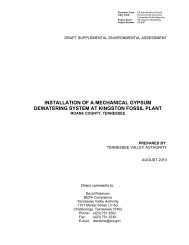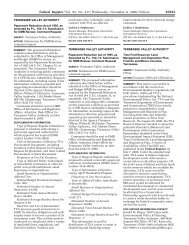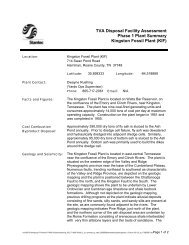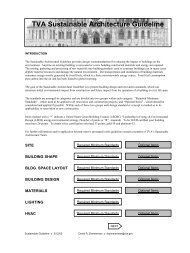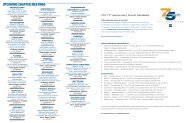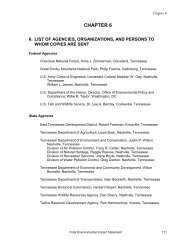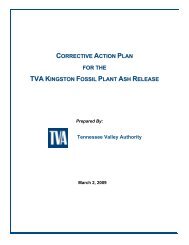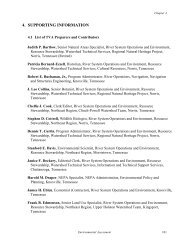Environmental Assessment - Tennessee Valley Authority
Environmental Assessment - Tennessee Valley Authority
Environmental Assessment - Tennessee Valley Authority
You also want an ePaper? Increase the reach of your titles
YUMPU automatically turns print PDFs into web optimized ePapers that Google loves.
No Action Alternative - The water intake and pipeline would not be installed; consequently,<br />
there would be no impacts to navigation.<br />
Action Alternative With Modification - The TVA navigation guideline for submarine pipeline<br />
crossings in commercial navigation channels on mainstream rivers is that the top elevation<br />
of the pipe or anchors should not be less than 3 feet below channel bottom grade. Channel<br />
bottom grade in the area is 724 feet. The original plans provided by LUB did not meet TVA<br />
navigation guidelines for installing water intakes. Minor design changes were required to<br />
lower the elevation of the main run of the pipeline (see Attachment E). The top of the<br />
buried pipeline and anchors would emerge from the bank below elevation 721 feet above<br />
msl and extend out along the river bottom perpendicular to the shoreline. At the end of the<br />
pipeline, the top of the intake screens are proposed to be at elevation 720.83 feet above<br />
msl, or 3.17 feet below channel bottom grade. The proposed action meets the minimum<br />
depth requirements. Additionally, shoreline warning signage indicating the presence of<br />
submerged pipelines should be clearly visible and legible from the water.<br />
Due to the amount of commercial and recreational activity in this area, timely<br />
communication of in-water work activities and schedules is imperative to reduce impacts to<br />
navigation. All in-water work activities and schedules should be coordinated with the<br />
USACE Nashville District for inclusion in a Notice to Navigation Interests as soon as the<br />
information is available. LUB should follow USACE’s guidance to minimize impacts from<br />
potential navigational situations during construction of the facilities, such as potential delays<br />
or rerouting during construction. Therefore, with the Section 26a Permit contingent upon<br />
the special conditions described in the Mitigation section, any impacts to navigation would<br />
be temporary and minor.<br />
Aquatic Ecology and Water Quality<br />
The <strong>Tennessee</strong> River has been impounded at numerous locations, including Fort Loudoun<br />
Dam that occurs upstream of the proposed project and Watts Bar Dam downstream.<br />
Sedimentation from agricultural practices, residential, commercial, and industrial<br />
development in the Watts Bar watershed has adversely impacted the aquatic habitat in the<br />
area. TDEC has the project area listed on the state’s Clean Water Act Section 303(d) list<br />
as impaired due to contaminated sediments from polychlorinated biphenyls (PCBs) and low<br />
dissolved oxygen (DO) from releases at Fort Loudoun Dam (TDEC 2008). Watts Bar<br />
Reservoir also has a fish consumption advisory for numerous species due to PCBs.<br />
The construction of a new raw water intake structure and piping would affect an area of<br />
riverbed approximately 500 feet long and 9.5 feet wide from installation of a 48-inch pipe<br />
and water from the water column withdrawn through five 27-inch intake screens at TRM<br />
592.3L. The construction of a 1,300-foot-long 24-inch-diameter water line entrenched in the<br />
riverbed across the <strong>Tennessee</strong> River at TRM 591.6, within 100 feet upstream of the US 11<br />
bridge, would affect approximately 1,000 feet of the riverbed within a path of up to 6 feet<br />
wide. An additional 50 feet downstream from each structure is expected to be influenced<br />
by indirect effects such as sedimentation and changes in hydrology.<br />
Substrate within the project area is predominately sand, gravel, and cobble occurring in the<br />
“transition zone” of Watts Bar Reservoir. Various habitats within Watts Bar Reservoir (and<br />
others throughout the TVA system) are routinely evaluated using TVA’s Ecological Health<br />
Monitoring Program to monitor reservoir health. The program provides data for comparing<br />
future water quality conditions, and serves as a screening program for targeting more<br />
detailed studies if the need arises. The ecological health scoring system is based on five<br />
10





